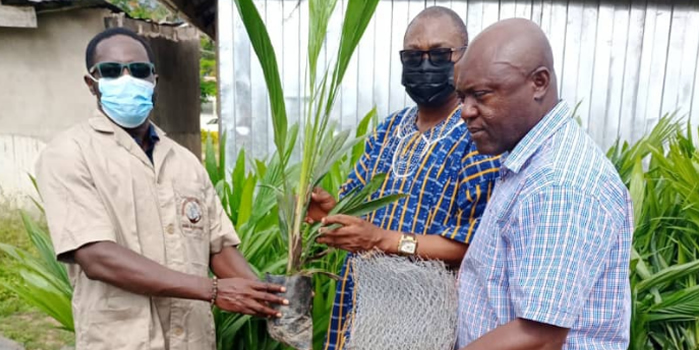

Health Care Delivery
The health delivery system in the Municipality even though is still faced with some problems just as it pertains in most rural communities in Ghana, the status of health in the Municipality over the years has improved significantly in several areas. Prominent among the major issues to be discussed in the health delivery system in the Municipality are incidence of disease, availability of health professionals, health infrastructure, status of the District Mutual Health Insurance Scheme (DMHIS), access to health facilities, and infant mortality rate and maternal mortality rate, etc.
Health service delivery in the Municipality is under the management of the District Health Management Team (DHMT) and is made up of eight main units. The main responsibility of the DHMT is to plan, coordinate, monitor and evaluate all health activities implemented in the Municipality.
The DHMT also mobilizes resources needed for effective health delivery in the Municipality. It collaborates with all stakeholders in health locally, nationally and internationally to bring quality and affordable health care to the people in the Municipality. It serves as the technical advisor to the Municipal Assembly on health issues and ensures the implementation of health policies in the Municipality.
The Municipality is divided into five sub-districts for easy implementation of health programmes, each headed by seasoned medical personnel. The five sub-districts have about 119 communities under them and they include Bibiani, Anhwiaso, Chirano, Awaso and Bekwai.
Incidence of Diseases
The top ten diseases, which are prevalent in the Municipality as at June 30, 2017, are indicated in Table 1.24. However, there are other diseases that are also featured prominently in the Municipality such as Diabetes Mellitus, Asthma, Snake bite, Infectious yaws, etc.
Despite the fact that malaria is still the number one top ten diseases as compared to the last four trend analysis, the number of reported cases has increased considerably from 95,678 cases 2013 to 102,784 in 2016. It is also still the number one cause of hospital admission in the district followed by hypertension anaemia and typhiod fever from 2014 to 2016 as shown in Table 27. With the exception of malaria, upper respiratory tract infection, etc which threatens the health of the people and causing hospital admission and possibly death, the general population/inhabitants of the Municipality are relatively healthy as portrayed by the number of reported cases of top ten diseases above which is very significant for increased productivity and production in the Municipality. Like in the country, malaria is the number one cause of morbidity in the Municipality.
Infant and Maternal Mortality
Available records from the District Health Directorate indicate that 6/1000 Live Birth (24), 18/1000 Live Birth (3.9) and 3.2/1000(8) Live Birth infant mortality rates were recorded in 2015, 2016 and 2017 respectively in the Municipality. The maternal mortality rates in the last three years also indicates 69/100000 Live Birth (3), 86/100000(4) Live Birth and 82/100000 (2) Live Birth in 2015, 2016 and mid-year of 2017 respectively. This trend or situation could be attributed largely to a number of factors such low skilled delivery, inadequate ANC, superstition, etc. On infant mortality, the Municipality recorded a quite high figure but all efforts are being employed by the Municipality to reduce it in order to achieve the SDG and AU Agenda 2053.
Health Infrastructure/Facility
Even though the health sector is under the direct management of the DHMT, other stakeholders from the public, private, Christian Health Association of Ghana (CHAG), NGOs and the mining companies have over the years contributed in diverse ways to the improvement of the health of the populace by providing out-patient, in-patient and outreach services to the people in the Municipality. The category and ownership of health facilities providing health services as well as spatial distribution in the Municipality are as shown in Table 1.26 and figure 1.11.
Figure 1.12: Health Facilities Map
Source: BABDA, 2017
These facilities which are almost evenly distributed four hospitals are capable of providing effective and efficient health care to the people
Health Personnel/ Professionals
Despite the fact that the existing health personnel situation in the Municipality has improved tremendously, the district still lacks the required personnel to man the health facilities in the Municipality. Most categories of health personnel required are available and are at post as indicated in Table 1.29. However, the district inadequate key personnel like Doctor, laboratory technicians, midwives, biostatistics assistants, etc.
Majority of the critical staff are located in the hospitals in Bibiani with a lot of the other staff like the Community Health Nurses widely distributed in all the health facilities and CHPS compounds. Table 1.29 captures the human resource of the Municipality.
The Municipality does not have adequate and good residential accommodation to attract staff. Private accommodation cost so much that the average workers cannot afford to pay. This has put the Municipality into a perpetual staff shortage situation.
Status of the District Mutual Health Insurance Scheme
The Bibiani-Anhwiaso-Bekwai Municipal population according to the 2010 population and housing census stood at 123,272 with an annual growth rate of about 1.8%. Based on this, the Municipality projected population as at the end of December, 2017 will stand 139,532. The District National Health Insurance Scheme in September, 2017 has active membership of 74,833 with 36,968 males and 37,865 females respectively. The NHIS also registered 19,448 subscribers made up of 5,831 males and 7,916 females including 4,291 pregnant women to join the scheme. The detailed status of the National Health Insurance in the has been discussed under cross-cutting issues section above of this plan.
Accessibility to Health Facilities
The geographical accessibility to health facilities by the people who are mostly farmers which was low when the Municipality was created in 1988, as a result of inadequate health facilities in the Municipality and their location of distances from the already scattered communities has improved tremendously within the last 12 years. The average distance in kilometres to the health facilities is 1.6 km and the distance in time is 50 minutes. Theses compare favourably with the planning standard of a maximum of 5km. The major implication is that there is a high physical access to the facilities and using accessibility to access the poverty situation, they are not poor in terms of health physically. With the introduction of National Health Insurance Scheme (NHIS) by the Government with free maternal care/delivery, OPD attendance continues to increase appreciably year on year on.
HIV AND AIDS
The Human Immuno-defiency Virus (HIV) and the Acquired Immune Deficiency Syndrome (AIDS) pandemic is a major source of worry to the country in general and the Municipality in particular.
Even though it is not among the top ten diseases in the Municipality, its incidence in the Municipality is on the increase. In view of this, the Municipal Assembly in collaboration with Ghana Health Service (GHS) put in place a framework to manage the spread of the infection. The District AIDS Committee (DAC) is set up to co-ordinate all HIV/AIDS activities in the Municipality. The District Hospital at Bibiani has a facility for counselling and testing. There is also a trained counsellor who is responsible for the provision of both pre- and post-test counselling services to clients. The Municipality has NGOs which receive funding from Ghana AIDS Commission (GAC). These NGOs and DA undertake a number of activities in the communities including public education on HIV/AIDS, condom distribution, mobile counselling and testing services and follow-up on clients who test positive for the virus.
The incidence of HIV/AIDS is quite prevalent in the 15-39 years age group. This is expected since they are sexually active. Other sexually transmitted infections that are reported at the Health Centres are syphilis, gonorrhoea, vaginal discharge, candidiasis, vagina welt, sores on penis and swollen scrotum. The development implication is that the active labour force of the population between ages 15-39 who are infected mostly will negatively affect productivity and production capacity of the Municipality.
The District Hospital at Bibiani has the mandate to screen all pregnant women who visit the centre for ante-natal services. This is to ensure that pregnant women who test positive are provided with antiretroviral drugs to prevent mother-to-child transmission. (PMTCT).
Date Created : 5/9/2023 12:00:00 AM













 facebook
facebook
 twitter
twitter
 Youtube
Youtube
 +233 593 831 280
+233 593 831 280 0800 430 430
0800 430 430 GPS: GE-231-4383
GPS: GE-231-4383 info@ghanadistricts.com
info@ghanadistricts.com Box GP1044, Accra, Ghana
Box GP1044, Accra, Ghana